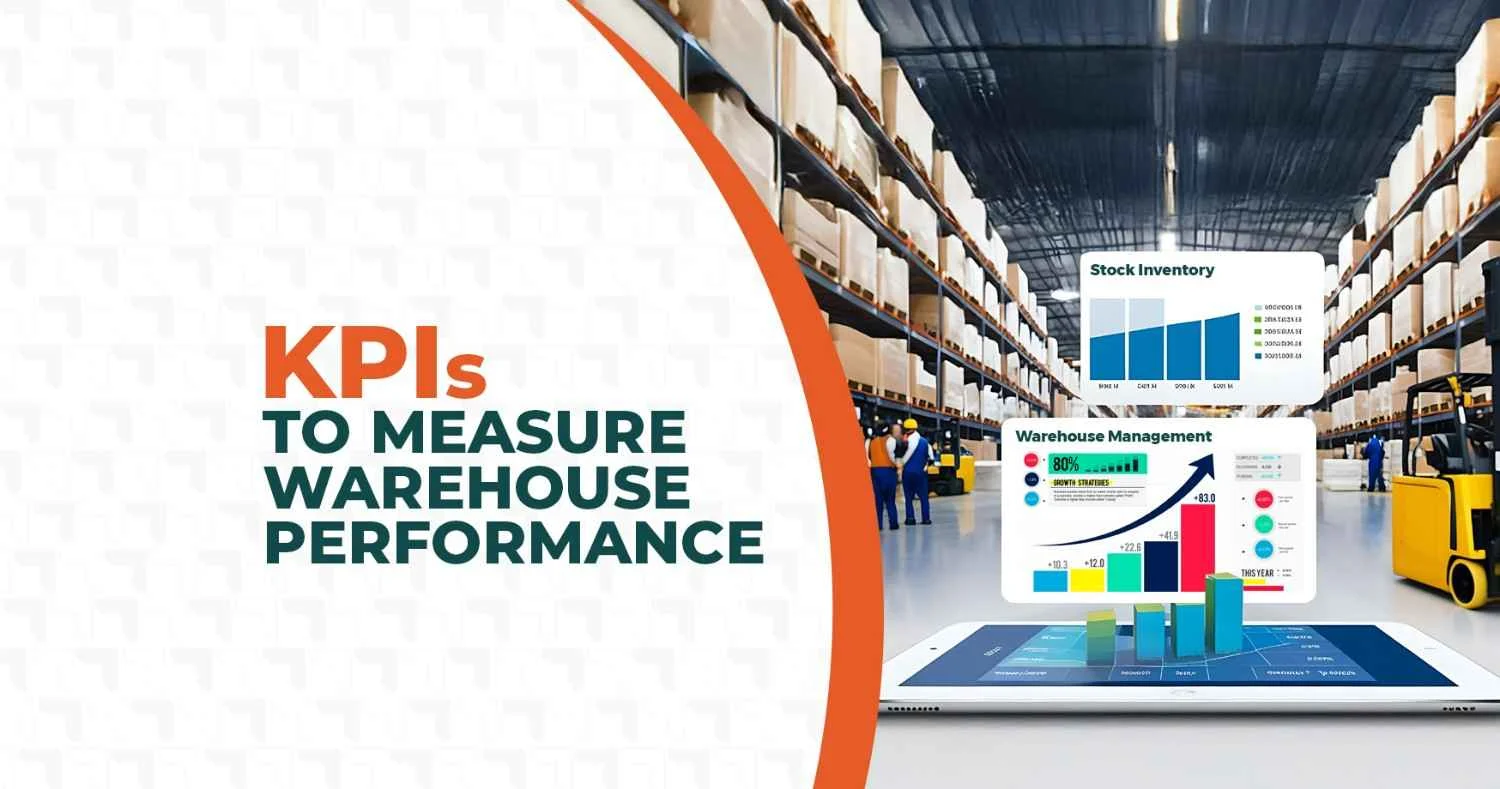
KPI to measure warehouse performance
Warehouses are essential for maintaining efficient operations and keeping customers satisfied, especially in a supply-driven business. Now a warehouse also has many processes within it, from inventory management to asset lifecycle management. Which means one disruption could lead to hampering the entire delivery schedule. In order to maintain the quality of your work through a holistic perspective, KPIs work tremendously well for this system.
With Key performance indicators to measure the warehouse performance, businesses get to monitor how fast, accurate, and efficient their processes are. Read this to understand how to track the most important warehouse performance KPIs, regardless of the industry or warehouse size, to ensure logistics are running at their best.
What are Warehouse KPIs?
Warehouse KPIs are structured metrics that are used to assess the efficiency and effectiveness of warehouse operations. They serve as objective measurement tools that give visibility into routine processes like order fulfillment, inventory handling, and space utilization. Instead of relying on intuition, teams use these metrics to understand performance trends and make data-driven decisions.
These indicators go beyond surface-level stats. They can track highly specific operational checkpoints from how efficiently goods move through receiving to how accurately items are picked and packed. This level of precision helps warehouse managers maintain consistency and adjust operations to meet both short-term and long-term goals.
At the end of the day, warehouse performance KPIs represent the pulse of the entire supply chain. When monitored consistently, they help identify workflow bottlenecks, reduce unnecessary costs, and uphold service quality. No matter the size of the operation, having clear KPIs in place ensures that every process is aligned with business objectives and continuously improving.
Key KPIs to Measure Warehouse Performance
Warehouse performance translates to how well each moving part supports the larger operational ecosystem. Key Performance Indicators (KPIs) help bring that clarity. They offer measurable insights into inventory control, order handling, space usage, labor efficiency, and customer satisfaction.
Warehouse KPIs highlight what’s working and reveal blind spots that may be silently affecting timelines, cost-efficiency, or service quality. Let’s learn more about a few of them:
3.1 Inventory Management KPIs
● Inventory Turnover Ratio: This KPI helps you understand how fast your inventory is moving. A high turnover rate usually means you’re not overstocking and that your goods are in demand. And a low turnover could signal slow-moving items taking up valuable space.
Formula: Cost of Goods Sold ÷ Average Inventory
● Stock Accuracy: Stock accuracy tells you how well your digital records match your physical stock. The more aligned they are, the fewer surprises you'll face during audits or order fulfillment. Regular cycle counts and using tools like RFID tags can go a long way in keeping things accurate and up to date.
● Days Sales of Inventory (DSI): DSI shows the average number of days it takes to sell your current inventory. A lower DSI means quicker turnover and faster cash flow. A high DSI might suggest that stock is just sitting, tying up capital and warehouse space.
3.2 Order Fulfillment KPIs
● Order Picking Accuracy: This KPI tells you how often warehouse staff pick the right items for customer orders. Mistakes here lead to returns, delays, and unhappy customers. Technologies like barcode scanners or RFID readers help reduce manual errors and ensure items are picked right the first time.
● Order Cycle Time: This measures the time from when an order is placed to when it’s delivered. A shorter cycle time usually means your processes are streamlined. Delays could point to bottlenecks in inventory access, packing, or shipping.
Formula: Delivery Date – Order Placement Date.
● On-Time Shipment Rate: This tracks how often shipments are sent out on or before their scheduled date. A high on-time rate indicates reliability. Warehouses can improve this by setting realistic cut-off times and using real-time order tracking systems.
3.3 Warehouse Efficiency KPIs
● Space Utilization: This shows how well you’re using your available warehouse space. If you’re not optimizing vertical space or aisle width, you might be spending more than needed on storage. Smart layout planning and adjustable shelving help get more out of the space you already have.
● Labor Productivity: This KPI looks at how efficiently your staff is working. It measures how many tasks are completed per shift or hour. Clear task assignment, training, and using handheld devices for faster scanning or input can boost overall productivity.
● Dock-to-Stock Cycle Time: This tells you how long it takes for goods to move from receiving at the dock to being available in your system. Long times can delay order fulfillment. Speeding this up requires better coordination between receiving, inspection, and data entry teams.
3.4 Customer Satisfaction KPIs
● Return Rate: This displays the frequency of product returns. A high return rate may indicate defective products, incorrect shipments, or issues with quality. Understanding why customers return items can help fix root issues and reduce future returns.
● Perfect Order Rate: This metric tracks the percentage of orders delivered on time, with the correct items, and no damages or errors. It’s a solid indicator of overall warehouse performance. Higher perfect order rates often reflect strong coordination between inventory, picking, packing, and shipping teams.
● Customer Order Lead Time: This gauges the amount of time that passes between a customer placing an order and receiving it. A shorter lead time usually conveys more positive customer experience and a higher possibility of repeat business.
How Technology Enhances Warehouse KPI Performance
Technology is now a fundamental enabler of reliable, data-driven performance in the warehouse operations of this era. Effective use eliminates the need for unnecessary speculation and helps businesses capture, track, and improve warehouse KPIs.
Technology provides clarity and control to processes that are otherwise prone to delays, errors, and inefficiencies. Let’s understand exactly how technology plays its part in this process:
1. Data and Analytics
- Real-time Visibility: Warehouse Management Systems (WMS) and cloud-based dashboards offer live updates on stock levels, item movement, and order status. This visibility helps teams manage inflow and outflow without relying on periodic checks or paper logs.
- KPI Tracking and Reporting: Instead of calculating metrics manually, systems now track KPIs like inventory accuracy or pick rates automatically and keeps managers informed and responsive.
- Data-Driven Optimization: Analytics tools help identify slow-moving SKUs, order delays, or space underutilization. This helps tweak strategies, restructure layouts, or reassign resources for better output.
2. Automation
- Task Automation: Warehouse operations often involve repetitive tasks like sorting, scanning, labeling, picking, and packing. With automation tools such as barcode scanners, RFID technology, conveyor belts, and voice-directed picking, these processes become streamlined and less labor-intensive. These integrations accelerate task completion and ensure consistent process execution across shifts and locations.
- Improved Accuracy: In manual environments, even the smallest error like misplacing a product or mistyping a SKU can disrupt entire workflows. Automation significantly reduces such risks. Warehouses can improve the integrity of outgoing orders, decrease mis-picks, and maintain cleaner inventory records by doing away with the need for manual checks. When handling high-value assets, multi-location inventories, or perishable goods, this accuracy is extremely helpful.
- Faster Throughput: The speed at which goods pass through the warehouse, or throughput, is one of the most apparent benefits of automation. Robotic pickers, sorting systems, and Automated Storage and Retrieval Systems (AS/RS) are examples of such developments that can manage several SKUs at once and frequently work around the clock without getting tired. For businesses operating in high-demand cycles, like e-commerce during festive seasons or manufacturing during bulk production, this speed can be a key differentiator in meeting SLAs and reducing lead times.
3. Specific KPIs and Technology Solutions
- Inventory Accuracy: Inventory accuracy refers to how closely the recorded inventory matches the actual physical stock on hand. With the help of Warehouse Management Systems (WMS) and barcode or RFID-based tracking, each item’s movement is automatically updated in real time, from receiving and shelving to picking and dispatching. This eliminates manual counting errors, prevents misplaced items, and ensures up-to-date stock levels. When businesses operate with high inventory accuracy, they can reduce safety stock, avoid overselling, and maintain better order fulfillment reliability.
- Order Fulfillment Time: Order fulfilment time calculates how long it takes for an order to be shipped out after a customer places it. Automated picking systems, smart packing stations, and route optimization tools work together to speed up this process. When the layout of the warehouse is designed for easy access and the picking flow is system-guided, there’s less backtracking and confusion. This simplified procedure increases operational agility and customer satisfaction by assisting companies in more reliably meeting delivery deadlines, even during times of high volume
- Warehouse Productivity: Productivity in warehouses measures how well people, equipment, and space are used to move goods. Automated storage and retrieval systems (AS/RS), mobile barcode scanners, and conveyors are examples of automation tools that businesses can incorporate to lessen the need for manual intervention.This ensures more tasks are completed in less time, helping companies achieve higher output with fewer resources and lower operational costs.
- Picking Cost: Picking cost evaluates the labor and time expenses involved in retrieving items from storage for outbound orders. By implementing automated picking technologies—like pick-to-light, pick-to-voice, or RFID-assisted picking—businesses can improve pick speed and reduce errors. When items are placed strategically based on frequency and weight (using tools like ABC analysis), staff spend less time walking and sorting. This directly lowers the cost per pick, improves order accuracy, and helps scale up order volume without significantly increasing manpower.
- Putaway Cycle Time: Putaway cycle time refers to how long it takes to store received goods in their proper warehouse locations. Using smart putaway algorithms within a WMS, businesses can assign the most logical and efficient storage spots based on item turnover rate, weight, or size. Mobile handhelds or voice-directed systems then guide staff to these slots, ensuring quicker placement with minimal searching. A shorter putaway time ensures faster stock availability for picking and keeps the receiving dock clear for incoming shipments.
- Receipt Performance: Receipt performance measures the efficiency of processing incoming inventory, it includes unloading to verification and final storageWith the help of RFID gates, barcode scanning, and integrated receiving checklists in WMS, teams can quickly compare shipments to purchase orders. As a result, there are fewer delays, fewer data entry errors, and shortens the time items are left idle before being stored. Improved receipt performance ensures inventory is recorded accurately and made available for sale or production faster, ultimately improving the supply chain’s responsiveness.
Best Practices to Optimize Warehouse Performance Using KPIs
Optimizing warehouse performance through KPIs involves tracking numbers and translating those numbers into real, measurable improvements. Key Performance Indicators give businesses a lens to evaluate how well their warehouse operations are functioning, mainly in terms of inventory control and space usage to order fulfillment and labor productivity.
Here are some of the best practices that will make make your KPI strategy practical and performance-driven:
● Setting realistic and measurable KPI targets.
Any successful KPI initiative starts with realistic goal-setting that is in line with business capabilities. It is important for targets to be quantifiable, relevant to your current operations, and grounded in realistic benchmarks. For example, setting a target for reducing order cycle time by 15% in the next quarter is more actionable than aiming for an abstract “faster processing.” It’s also important to set KPIs based on historical performance data and industry standards, ensuring expectations are ambitious but attainable.
● Continuous monitoring and data-driven decision-making.
Once KPIs are in place, real-time monitoring becomes essential. Dashboards within Warehouse Management System Solution (WMS) or ERP tools help track day-to-day performance and flag deviations early. Teams can then take action to fix things before minor shortcomings turn into significant operational problems. Businesses can make data-supported decisions over time, such as updating inventory procedures, redistributing labour, or changing workflows. Understanding the data and consistently acting upon it is much more crucial than merely gathering it.
● Regular training programs for warehouse staff.
Even with the most advanced technology and perfectly defined KPIs, warehouse performance ultimately depends on the people on the floor. Regular training and upskilling programs ensure that staff understand what are the KPIs they must fulfill, how their daily work impacts those metrics, and how to use necessary tools like barcode scanners, handheld devices, or automated pick lists (as required in their process).
● Investing in automation and smart inventory systems.
When it comes to consistently accomplishing warehouse KPIs, technology is a powerful catalyst. The dedicated equipment improve accuracy, speed up productivity, and free up valuable manpower by decreasing reliance on manual processes. AI-driven demand forecasting and RFID-powered intelligent inventory systems, on the other hand, provide real-time stock visibility and smarter planning. When these technologies are successfully incorporated into your KPI tracking system, they actively promote improvements throughout your operations rather than merely collecting performance data.
Conclusion
Warehouse KPIs signal how well your operations are performing. Right from inventory control and order picking rates to receiving efficiency, space utilization, and shipment timelines, each KPI sheds light on specific areas that impact the productivity rate and customer satisfaction.
Tracking these metrics consistently allows businesses to identify bottlenecks, adjust workflows accordingly, reduce operational costs, and make better decisions backed by real-time data. It’s not a one-time activity but an ongoing practice that leads to continuous improvement and long-term scalability.
Want to Improve your Warehouse Performance? Contact Barcode India today and explore smart solutions that bring clarity, control, and efficiency to your warehouse.
FAQs
1. What are the 5 KPIs for a warehouse?
Ans: The top 5 warehouse KPIs include inventory accuracy, shrinkage, carrying cost, inventory turnover, and inventory-to-sales ratio—each essential for tracking performance and managing stock effectively.
2. What three key performance indicators are available in the warehouse operations dashboard?
Ans: The main warehouse dashboard KPIs are Inventory Value, Hit or Miss Accuracy, and Exact Matches Rate, helping teams monitor efficiency, accuracy, and real-time operational health.
3. What is KPI in warehouse space utilization?
Ans: This KPI shows how effectively warehouse space is used. It's calculated by comparing total storage volume to available capacity, revealing underused or overfilled storage areas.
4. What is the KPI in warehouse turnover?
Ans: Inventory turnover indicates how often inventory is sold and replaced. A higher rate suggests efficient stock management, helping reduce holding costs and prevent overstocking.
5. Why is monitoring Warehouse KPIs important for businesses?
Ans: Tracking warehouse KPIs ensures better visibility, improved inventory control, reduced costs, higher customer satisfaction, and helps businesses stay competitive through smarter, data-backed operational decisions.
Share this page
Get in Touch
Ready to take your business to the next level with BCI (Bar Code India)? We're just a phone call or email away.



